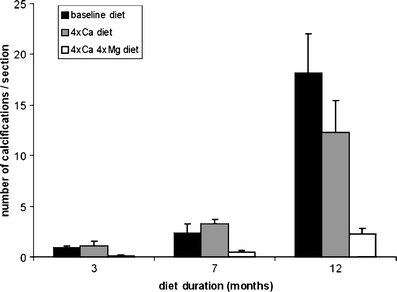Dietary magnesium, not calcium, prevents vascular calcification in a mouse model for pseudoxanthoma elasticum
- PMID: 20177653
- PMCID: PMC2859158
- DOI: 10.1007/s00109-010-0596-3
Dietary magnesium, not calcium, prevents vascular calcification in a mouse model for pseudoxanthoma elasticum
Abstract
Pseudoxanthoma elasticum (PXE) is a heritable disorder characterized by ectopic calcification of connective tissue in skin, Bruch's membrane of the eye, and walls of blood vessels. PXE is caused by mutations in the ABCC6 gene, but the exact etiology is still unknown. While observations on patients suggest that high calcium intake worsens the clinical symptoms, the patient organization PXE International has published the dietary advice to increase calcium intake in combination with increased magnesium intake. To obtain more data on this controversial issue, we examined the effect of dietary calcium and magnesium in the Abcc6(-/-) mouse, a PXE mouse model which mimics the clinical features of PXE. Abcc6(-/-) mice were placed on specific diets for 3, 7, and 12 months. Disease severity was measured by quantifying calcification of blood vessels in the kidney. Raising the calcium content in the diet from 0.5% to 2% did not change disease severity. In contrast, simultaneous increase of both calcium (from 0.5% to 2.0%) and magnesium (from 0.05% to 0.2%) slowed down the calcification significantly. Our present findings that increase in dietary magnesium reduces vascular calcification in a mouse model for PXE should stimulate further studies to establish a dietary intervention for PXE.
Figures





Comment in
-
Vascular calcification and magnesium.J Mol Med (Berl). 2010 May;88(5):437-9. doi: 10.1007/s00109-010-0604-7. J Mol Med (Berl). 2010. PMID: 20300725 No abstract available.
Similar articles
-
Restricting dietary magnesium accelerates ectopic connective tissue mineralization in a mouse model of pseudoxanthoma elasticum (Abcc6(-/-) ).Exp Dermatol. 2012 Sep;21(9):694-9. doi: 10.1111/j.1600-0625.2012.01553.x. Exp Dermatol. 2012. PMID: 22897576 Free PMC article.
-
Elevated dietary magnesium prevents connective tissue mineralization in a mouse model of pseudoxanthoma elasticum (Abcc6(-/-)).J Invest Dermatol. 2009 Jun;129(6):1388-94. doi: 10.1038/jid.2008.391. Epub 2009 Jan 1. J Invest Dermatol. 2009. PMID: 19122649 Free PMC article.
-
Magnesium carbonate-containing phosphate binder prevents connective tissue mineralization in Abcc6(-/-) mice-potential for treatment of pseudoxanthoma elasticum.Clin Transl Sci. 2009 Dec;2(6):398-404. doi: 10.1111/j.1752-8062.2009.00161.x. Clin Transl Sci. 2009. PMID: 20443931 Free PMC article.
-
ABCC6 and pseudoxanthoma elasticum.Pflugers Arch. 2007 Feb;453(5):685-91. doi: 10.1007/s00424-005-0039-0. Epub 2006 Apr 8. Pflugers Arch. 2007. PMID: 16604369 Review.
-
ABCC6, Pyrophosphate and Ectopic Calcification: Therapeutic Solutions.Int J Mol Sci. 2021 Apr 27;22(9):4555. doi: 10.3390/ijms22094555. Int J Mol Sci. 2021. PMID: 33925341 Free PMC article. Review.
Cited by
-
Supplement With Calcium or Alendronate Suppresses Osteopenia Due to Long Term Rabeprazole Treatment in Female Mice: Influence on Bone TRAP and Osteopontin Levels.Front Pharmacol. 2020 May 13;11:583. doi: 10.3389/fphar.2020.00583. eCollection 2020. Front Pharmacol. 2020. PMID: 32477111 Free PMC article.
-
Metal Ion-Loaded Nanofibre Matrices for Calcification Inhibition in Polyurethane Implants.J Funct Biomater. 2017 Jun 23;8(3):22. doi: 10.3390/jfb8030022. J Funct Biomater. 2017. PMID: 28644382 Free PMC article.
-
Serum Magnesium Levels and Cardiovascular Outcomes in Systolic Blood Pressure Intervention Trial Participants.Kidney Med. 2023 Mar 28;5(6):100634. doi: 10.1016/j.xkme.2023.100634. eCollection 2023 Jun. Kidney Med. 2023. PMID: 37235044 Free PMC article.
-
Low Magnesium Levels and FGF-23 Dysregulation Predict Mitral Valve Calcification as well as Intima Media Thickness in Predialysis Diabetic Patients.Int J Endocrinol. 2015;2015:308190. doi: 10.1155/2015/308190. Epub 2015 May 18. Int J Endocrinol. 2015. PMID: 26089881 Free PMC article.
-
Rate of change of carotid intima-media thickness with magnesium administration in Abcc6⁻/⁻ mice.Clin Transl Sci. 2013 Dec;6(6):485-6. doi: 10.1111/cts.12057. Epub 2013 Apr 19. Clin Transl Sci. 2013. PMID: 24330694 Free PMC article.
References
-
- Gheduzzi D, Sammarco R, Quaglino D, Bercovitch L, Terry S, Taylor W, Ronchetti IP. Extracutaneous ultrastructural alterations in pseudoxanthoma elasticum. Ultrastruct Pathol. 2003;27:375–384. - PubMed
Publication types
MeSH terms
Substances
LinkOut - more resources
Full Text Sources

